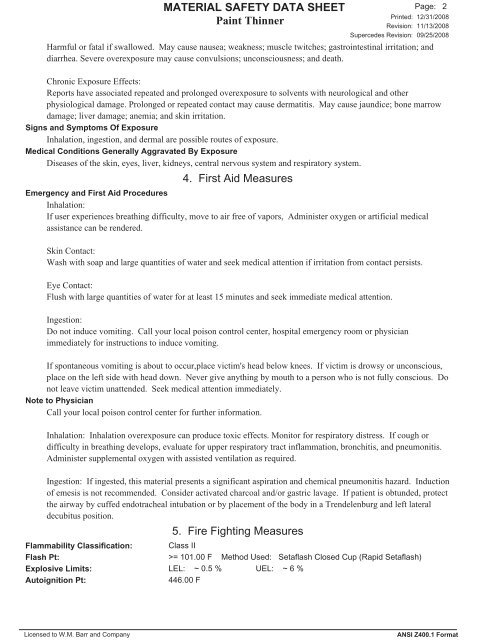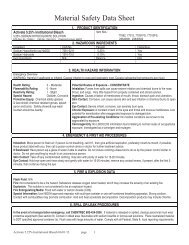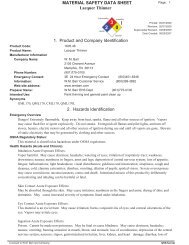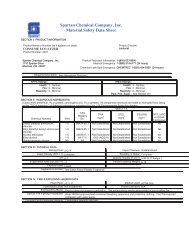Paint Thinner MSDS - Case School of Engineering
Paint Thinner MSDS - Case School of Engineering
Paint Thinner MSDS - Case School of Engineering
You also want an ePaper? Increase the reach of your titles
YUMPU automatically turns print PDFs into web optimized ePapers that Google loves.
MATERIAL SAFETY DATA SHEET<br />
<strong>Paint</strong> <strong>Thinner</strong><br />
Page:<br />
Printed: 12/31/2008<br />
Revision: 11/13/2008<br />
Supercedes Revision: 09/25/2008<br />
Harmful or fatal if swallowed. May cause nausea; weakness; muscle twitches; gastrointestinal irritation; and<br />
diarrhea. Severe overexposure may cause convulsions; unconsciousness; and death.<br />
2<br />
Chronic Exposure Effects:<br />
Reports have associated repeated and prolonged overexposure to solvents with neurological and other<br />
physiological damage. Prolonged or repeated contact may cause dermatitis. May cause jaundice; bone marrow<br />
damage; liver damage; anemia; and skin irritation.<br />
Signs and Symptoms Of Exposure<br />
Inhalation, ingestion, and dermal are possible routes <strong>of</strong> exposure.<br />
Medical Conditions Generally Aggravated By Exposure<br />
Diseases <strong>of</strong> the skin, eyes, liver, kidneys, central nervous system and respiratory system.<br />
4. First Aid Measures<br />
Emergency and First Aid Procedures<br />
Inhalation:<br />
If user experiences breathing difficulty, move to air free <strong>of</strong> vapors, Administer oxygen or artificial medical<br />
assistance can be rendered.<br />
Skin Contact:<br />
Wash with soap and large quantities <strong>of</strong> water and seek medical attention if irritation from contact persists.<br />
Eye Contact:<br />
Flush with large quantities <strong>of</strong> water for at least 15 minutes and seek immediate medical attention.<br />
Ingestion:<br />
Do not induce vomiting. Call your local poison control center, hospital emergency room or physician<br />
immediately for instructions to induce vomiting.<br />
If spontaneous vomiting is about to occur,place victim's head below knees. If victim is drowsy or unconscious,<br />
place on the left side with head down. Never give anything by mouth to a person who is not fully conscious. Do<br />
not leave victim unattended. Seek medical attention immediately.<br />
Note to Physician<br />
Call your local poison control center for further information.<br />
Inhalation: Inhalation overexposure can produce toxic effects. Monitor for respiratory distress. If cough or<br />
difficulty in breathing develops, evaluate for upper respiratory tract inflammation, bronchitis, and pneumonitis.<br />
Administer supplemental oxygen with assisted ventilation as required.<br />
Ingestion: If ingested, this material presents a significant aspiration and chemical pneumonitis hazard. Induction<br />
<strong>of</strong> emesis is not recommended. Consider activated charcoal and/or gastric lavage. If patient is obtunded, protect<br />
the airway by cuffed endotracheal intubation or by placement <strong>of</strong> the body in a Trendelenburg and left lateral<br />
decubitus position.<br />
5. Fire Fighting Measures<br />
Flammability Classification: Class II<br />
Flash Pt: >= 101.00 F Method Used: Setaflash Closed Cup (Rapid Setaflash)<br />
Explosive Limits: LEL: ~ 0.5 % UEL: ~ 6 %<br />
Autoignition Pt:<br />
446.00 F<br />
Licensed to W.M. Barr and Company<br />
ANSI Z400.1 Format

















